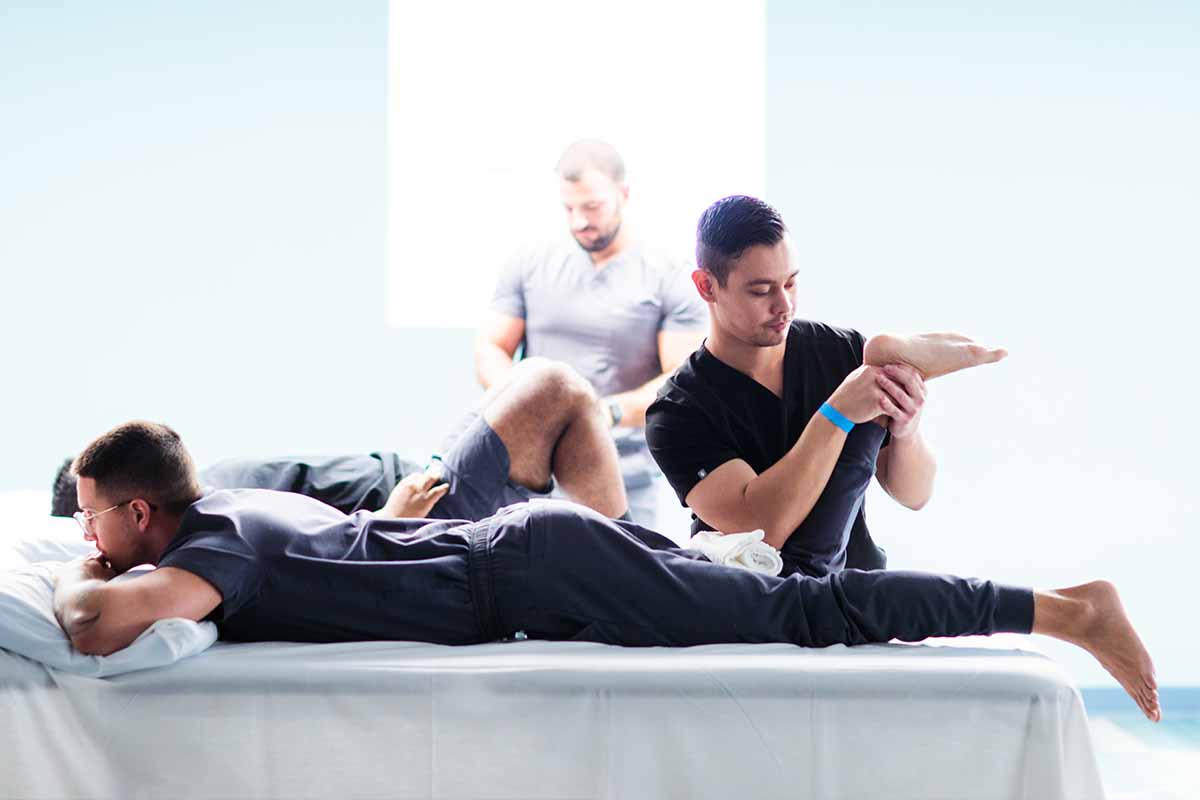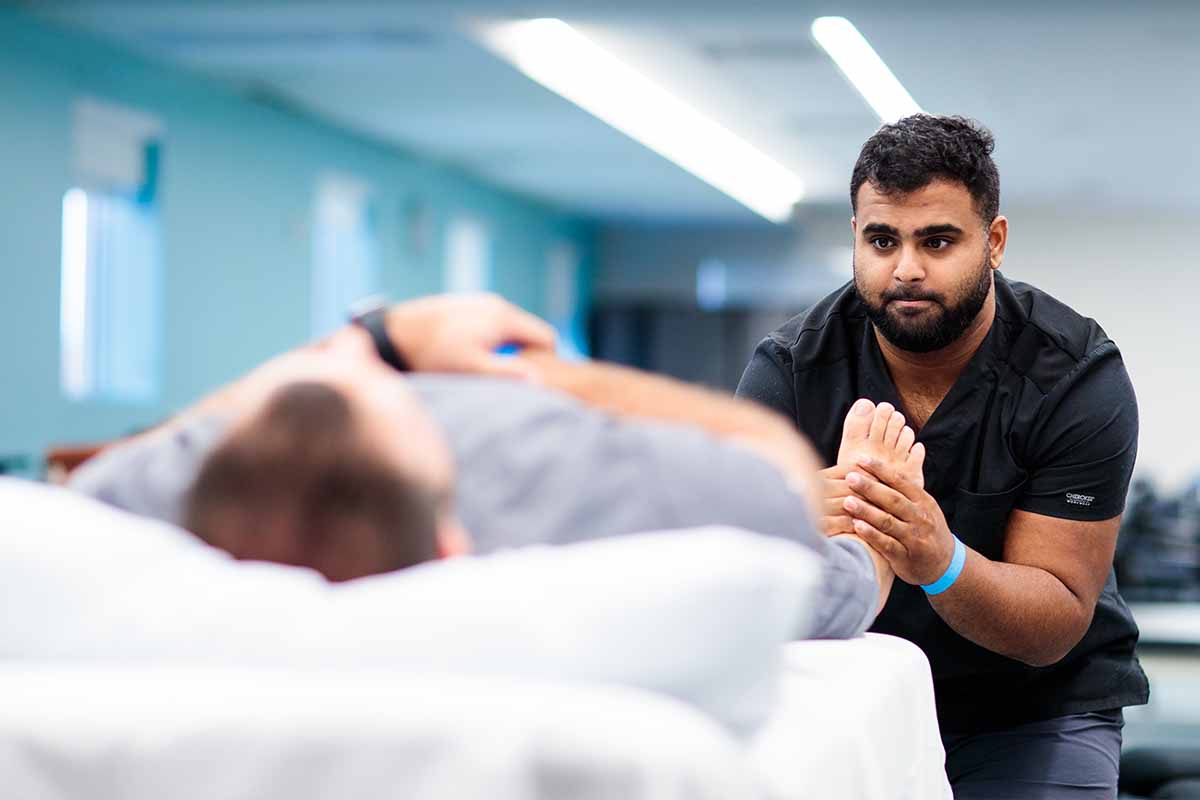
In the high-stakes world of professional baseball, where every pitch, swing and play holds the weight of expectation and competition, there is an individual behind the scenes who plays a crucial role in keeping the players in top form.
Byron Campbell, PT, DPT, ATC, CSCS, MDNC, USAHS DPT alum, is a former Division 1 and professional baseball player turned physical therapist (PT). His work represents the value of empathy and personalized care in rehabilitation.
A Background in Motion: From Player to Patient to Practitioner
Dr. Campbell’s story begins in the fields of Maryland, where he honed his skills as a multi-sport athlete from a young age. “I played football, basketball, baseball and ran track,” he recalls.
Baseball captured his heart, leading him to pursue his dreams at the collegiate level and beyond. After a four-year run with the University of Maryland Eastern Shore, a shoulder injury derailed Dr. Campbell’s professional baseball goal.
However, this setback was the catalyst for his pursuit of health sciences.
“Going through PT and rehab inspired me to return to school and pursue a master’s degree in athletic training,” he reflects.
It was during his time in the University of St. Augustine for Health Sciences (USAHS) Doctor of Physical Therapy (DPT) program that Dr. Campbell’s trajectory took a definitive turn. “USAHS prepared me for high-stress moments,” he shares. At USAHS, Dr. Campbell honed his clinical skills and cultivated a deep understanding of the significance of patient-centered care.
One clinical rotation stands out—his work at a sports medicine clinic in Texas—where he had the opportunity to learn from renowned surgeon Keith Meister, MD. “He taught me a lot and helped guide my path,” he recalls.
Stepping Up to the Plate: A Career Milestone with the Baltimore Orioles
Armed with newfound expertise and passion for sports medicine, Dr. Campbell embarked on his next chapter. He is now in his third year as a Minor League Physical Therapist for the Baltimore Orioles.
Despite being a recent graduate, his in-depth knowledge of the game and his ability to build relationships set him apart in a competitive field. “I got the job two months after DPT graduation,” he recounts.
Dr. Campbell wears many hats with the Orioles, from preparing players for fieldwork to managing post-op rehabilitation and post-game treatment. He also develops maintenance plans for recently injured athletes. Based in Sarasota, Florida, minor and major league players fly to him for rehabilitation, and he travels with the major league team each year.
What does rehabilitation look like? Dr. Campbell treats a range of injuries, both upper and lower extremity injuries, including Tommy John and ACL reconstruction, SLAP repairs, hamstring, quadriceps and oblique strains, concussions and more.
He focuses on positivity and effective communication.
“I don’t see this position as pressure-filled as I’ve been on the other side. If I give everything I have toward rehabilitation and inspire the athletes I work with to do the same, I’m at peace,” he says.
Lessons Learned: Navigating the Road Ahead
As Dr. Campbell reflects on his transition from athlete to therapist, he shares insights from triumphs and trials. “Rehab is challenging,” he quips, acknowledging its grueling nature.
His experiences drive him to advocate for holistic care and preventive measures. “Learn from my mistakes,” he urges, emphasizing the need for nutrition, self-care and injury prevention in optimizing performance and longevity.
His success stories include a player who spent an extended amount of time with Dr. Campbell doing rehabilitation and then went back to the field to win the game that sent the Orioles to the playoffs last year.
“The number one most memorable moment of all of them, and it happens with every single guy, is when we can finally bring them into the office and let them know that they’re returning up north,” he says.
Dr. Campbell emphasizes the influence of communication, compassion and continuous learning in navigating the complexities of sports rehabilitation.


Strategic Empowerment: Investing in Tomorrow’s Sports PTs
Dr. Campbell’s is committed to mentoring future physical therapists and invites two USAHS students each semester to work alongside him during clinical rotations. These opportunities provide invaluable experiences and offer insights into sports rehabilitation.
Among these students is Megann Schooley, PT, DPT, USAHS assistant professor, PT programs, and former athletic trainer. Dr. Schooley says of the experience, “He pushes us to figure out how to make our work functional or multi-directional.”
Similarly, Beau, with a background in collegiate baseball, finds a special connection with Dr. Campbell.
“Byron spends a lot of time getting players from point A to point B. Watching this happen is my favorite part,” he says.
Dr. Campbell carefully selects students based on their ability to engage with patients and their openness to learning. He underlines the importance of building trust and rapport. He believes that while you can teach clinical skills, the ability to connect with patients on a personal level is paramount.
As the rotation progresses, Dr. Campbell empowers students to lead medical meetings and take charge of patient care. This hands-on approach fosters confidence and instills a sense of ownership in students as they witness the tangible impact of their contributions.
“By the end of the experience, I can step back and let the students run the show. They don’t want to leave, players don’t want them to leave,” Dr. Campbell says. Through his guidance and support, physical therapists emerge with the requisite clinical skills and compassion needed to make a difference in the lives of their patients.
Closing the Circle: A Legacy of Excellence
As Dr. Campbell advances his career, his impact extends beyond the baseball diamond. Through his mentorship of students and dedication to patient care, he embodies the power of passion and perseverance.
Dr. Campbell’s approach remains steadfastly patient-centric. “He treats players as people, not as products, which builds trust,” says Dr. Schooley.









